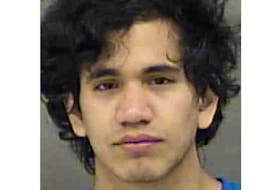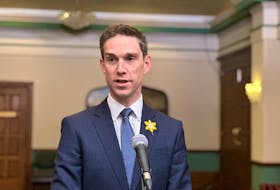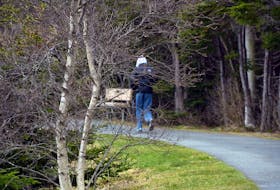You might not have noticed, but Freemasonry has been alive and well in this province for quite some time.
The fraternity, steeped in history and tradition with connections all over the world, has been quietly going about its work away from the public eye for centuries.
That, however, is changing.
The District Grand Lodge of Newfoundland and Labrador, Grand Lodge Scotland, is marking its 150th anniversary in the province Saturday and is using the occasion to help raise the profile of Freemasonry.
It also wants to counter those who have labelled the Freemasons as a mysterious, secret society that only cares about its own members.
A huge sign has been erected outside the Freemasons Hall at Masonic Park in Mount Pearl — and at its lodges in other parts of the province — announcing the anniversary. They’ve talked to the media, something that has rarely happened over the years.
Masonic Park, a large senior citizens housing complex, is a testament to the work done by the District Grand Lodge of Newfoundland and Labrador, as is a more than 20-year involvement with the Kids Eat Smart program and other charitable causes.
But what is Freemasonry? According to the District’s website, “Freemasonry is a system of morality, veiled in allegory and illustrated by symbols.”
Bestselling books such as Dan Brown’s “The Da Vinci Code” and its subsequent movie have sparked interest in Freemasonry in recent years with its purported connections to the Knights Templar and the Illuminati, and the alleged involvement of those organizations in protecting some of the world’s greatest religious artifacts.
That kind of interest is not what Freemasonry desires. It simply wants to promote its principles of brotherly love, relief and truth, and attract new members with strong moral characteristics.
Scott Bartlett, district grand master of the District Grand Lodge of Newfoundland and Labrador, said members get out of Freemasonry what they are willing to put in. He said members are encouraged to do things that make a difference in their own life, their family, their lodge and their community.
“There are a number of lessons we teach each of our members and it has to do with your moral improvement,” Bartlett said. “To make good men better.”
The District Grand Lodge was formed in 1868 and has grown to include 11 lodges and 450 members across Newfoundland and Labrador. Grand Lodge of Scotland is headquartered in Edinburgh with affiliated lodges and members everywhere, from North America to Australia.
Charles Iain R. Wolrige Gordon of Esslemont, grand master mason with the Grand Lodge of Scotland, travelled to St. John’s for the anniversary events that will include a rededication ceremony, a tree planting and celebrations of the achievements of the District Grand Lodge.
He said the district, and the “craft” of Freemasonry generally, will face new challenges in the future — as are many organizations — with society experiencing a period of rapid change. Communications, for instance, have dramatically changed during the last decade and to survive, he said, Freemasonry must embrace change without compromising its principles.
“In Scotland, as is in many countries, we’ve become a me-me society. … They don’t want to get out and help other people, to be involved in the community,” Gordon said. “Masonry is very much helping other people and that’s where we are frequently targeted with, ‘Oh, you only look after each other,’ and that totally is not true. Absolute rubbish. Look at what we’ve done here in Newfoundland.”
Gordon said how Freemasonry is currently practised worldwide stemmed from Scotland in the 12th century.
“In Scotland we have the oldest masonic minutes ever recorded, and that goes back to 1598 or 1599,” Gordon said. “Some people might turn around and use the word ‘antiquated,’ which is probably rather unkind. If you went back 100 years, anyone who was anyone within society, the structure of the villages, to them it was a privileged position to be regarded as a Freemason, so the membership was very, very large. There are all these bodies who are anti-Freemasonry and they attack us on completely and utterly unfounded bases. They know little about us.”
The tradition of Freemasonry can be traced back to the associations of operative masons, the men who built the cathedrals, abbeys and castles of Europe during the Middle Ages. With the decline of cathedral building in the 17th century, many guilds of masons — to keep their numbers up — started to accept men who were not working as masons and referred to those members as “speculative” masons.
Speculative masons make up the lodges of modern-day Freemasonry, the oldest and largest worldwide fraternity. The tools of a mason are symbolically used in the teachings of members.
Requirements to become a Freemason include having a strong moral character, having a good reputation in the community, believing in God (in a supreme being), being 21 years of age and being able to meet monetary obligations imposed by being a member without detriment to oneself or family.
There are three degrees of Freemasonry — the third degree, when reached, gives a person the title of master mason.
And at Masonic meetings, politics and religion are not permitted to be discussed.
The rituals and customs of old, however, still take place during meetings. These are practices that have gone unchanged for hundreds of years.
“I strongly believe in ritual that we had that’s been passed down through time, 300 or 400 years ago,” Gordon said. “That, to me, is the cornerstone of Freemasonry — the ritual, what you’ve learned from it, what you take out of it. To be honest, when I first joined the craft, I thought I had never heard such mumbo jumbo in my life and I couldn’t understand what was going on. But it’s not until you attend your lodge that you understand the great depth in there and the huge explanation.”
glen.whiffen@thetelegram.com
Enjoy this story? Subscribe to our e-edition for $1.99 a week at http://bit.ly/2rofvW2.








